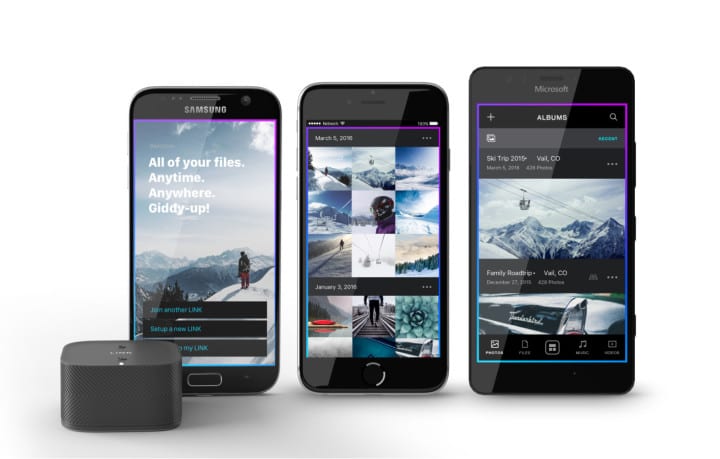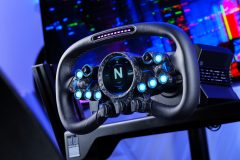Samsung has been known for packing cutting-edge tech into its mobile devices while keeping them thin and light. Take the Galaxy S7 and Galaxy S7 edge: announced last Spring, these devices pack the fast UFS 2.0 flash storage along with Samsung’s Dual Pixel phase detection autofocus (PDAF) and the company’s new magnetic secure transmission (MST) mobile payments tech into a slim smartphone that feels unrealistically light at first grip. The Gear S3 is the first smartwatch on the market to pack a 64-bit graphics chip, the same type of chip placed in the Galaxy S7 and Galaxy S7 edge; it essentially gives you a 720p viewing experience on your wrist. A few years ago, it would have been unreal to fathom these types of technologies in devices that sit in the palm of your hand.
Samsung continues to stun the mobile world with the best technology in small chips that go inside electronic devices by partnering with Fasetto to introduce the living storage and communications device known as LINK at CES 2017, the world-renown Consumer Electronics Show in Las Vegas.
LINK has an incredibly small form factor, weighing as little as 3 ounces – officially classifying this device as pocket-sized (1 inch tall, 2 inches across). Apart from its lightweight nature and pocket portability, LINK also packs an industry-first NVMe PCle with a single ball grid array or BGA SSD (referring to the new integrated circuit layout in the manufacturing process that maintains the thinness of computer devices). LINK comes with 2TB of onboard storage and features Samsung’s 2.1Ghz, octa-core, Exynos 7420 SoC. The Exynos 7420, if you recall, is the same one found in Samsung’s Galaxy Note 5 announced and released in 2015 that crushed the performance of the overheating Qualcomm Snapdragon 810. The Exynos 7420 SoC proved to be the fastest processor on the market in 2015, and is still one of the most beloved processors in Samsung’s Exynos series.
“LINK combines the most powerful commercially-available hardware with an incredibly sleek, but tough, design. In LINK, we now have a living storage and communications device and platform that lets you stream, store and share all of your digital files through one secure location that can survive almost anything. What’s more, the LINK developer kit opens up vast, astonishing new opportunities for the LINK Platform in today’s IoT and connected world,” said Fasetto co-founder and CEO Coy Christmas.
LINK packs other technologies, too, apart from the Exynos 7420. It brings along cellular, Bluetooth, WiFi, and USB-C connections so that users are not limited to one platform in which to share or access content. LINK is also weatherproof and able to survive heat, cold, and the occasional trip through the washing machine (the vulnerability of pocket-sized devices). User permissions, security software, and layers of hardware and software encryption give users the protection they need to share and access data with peace of mind.
LINK is not only flexible with platforms; it is also flexible in its design and communication with other devices. LINK’s components can be replaced or removed, and the LDK (LINK Developer Kit) lets anyone write code for the device and connect it to other devices such as cars and even smart fridges. This is the Internet-of-Things (IoT) agenda at its finest: in an ideal scenario, all devices can talk to each other, even if it’s a smart door knob talking to your refrigerator – or your Gear S3 Frontier talking to your Ford vehicle. You can view LINK on display at CES from January 5th through Sunday, January 8th.
With its powerful technology in a lightweight package, it’s no surprise then that LINK has won CES 2017 awards in four categories: Computer Accessories, Software and Mobile Apps, Computer Hardware and Components, and Wireless Handset Accessories. The device that packs a punch with powerful Samsung technologies will be available for purchase this Spring (2017).
Most Popular Tech Stories
- Kelly Betting – How It Works and the Kelly Criterion Explained
- What are Pokies? – The Latest Guide to How Pokies Work in Australia
- AI industry needs annual revenues of more than the UAE’s GDP to offset costs
- Pepe Unchained Meme Token ICO Hits $2 Million – Could PEPU See a Post-Launch Surge Like PEPE?
- 4 Best Meme Coins to Buy with 100x Gains Potential – Top Picks for July 2024
Latest News
Does AI increase productivity at work? New study suggests otherwise
Artificial intelligence software reduces productivity and harms the working environment, according to a study from the freelance platform, Upwork. The findings appear to question how AI is being deployed at...


















